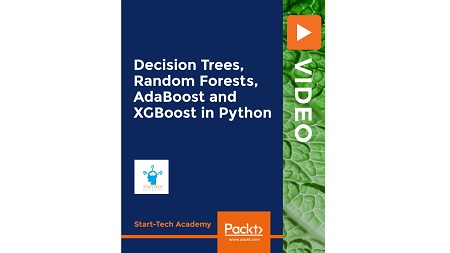
English | MP4 | AVC 1366×768 | AAC 44KHz 2ch | 5h 05m | 2.45 GB
Decision trees and ensembling techniques in Python. How to run bagging, random forests, GBM, AdaBoost, and XGBoost in Python
You’re looking for a complete decision tree course that teaches you everything you need to create a Decision tree/Random Forest/XGBoost model in Python, right? You’ve found the right Decision Tree- and tree-based advanced techniques course!
If you are a business manager, executive, or student and want to learn and apply Machine Learning to real-world business problems, this course will give you a solid base for that by teaching you some advanced machine learning techniques: Decision Trees, Random Forests, Bagging, AdaBoost, and XGBoost.
This course covers all the steps you should take while solving a business problem through Decision Trees. Most courses only focus on teaching you how to run an analysis, but we believe that what happens before and after running analyses is even more important: before running an analysis, it is very important that you have the right data and do some pre-processing on it. And after running an analysis, you should be able to judge how good your model is and interpret the results so it actually helps your business.
The course is taught by Abhishek and Pukhraj. As managers in the Global Analytics Consulting firm, we have helped businesses solve their business problems using Machine Learning techniques and we have used our experience to include practical aspects of data analysis in this course. We are also the creators of some of the most popular online courses—with over 150,000 enrollments.
Teaching our students is our job and we are committed to it. If you have any questions about the course content, practice sheet, or anything related to any topic, you can always post a question in the course or send us a direct message. With each lecture, there are class notes attached for you to follow along. You can also take quizzes to check your understanding of concepts. Each section contains a practice assignment for you to implement what you’ve learned practically. This course teaches you all the steps involved in creating Decision Tree-based models (some of the most popular Machine Learning models) to solve business problems.
Learn
- Get a solid understanding of Decision Trees
- Understand business scenarios where a Decision Tree is applicable
- Tune a machine learning model’s hyperparameters and evaluate its performance.
- Use Pandas DataFrames to manipulate data and make statistical computations.
- Use Decision Trees to make predictions
- Learn the advantage and disadvantages of the various algorithms
Table of Contents
Introduction
1 Welcome to the Course!
Machine Learning Basics
2 Introduction to Machine Learning
3 Building a Machine Learning Model
Setting up Python and Python Crash Course
4 Installing Python and Anaconda
5 Opening Jupyter Notebook
6 Introduction to Jupyter
7 Arithmetic operators in Python – Python Basics
8 Strings in Python – Python Basics
9 Lists, Tuples and Directories – Python Basics
10 Working with Numpy Library of Python
11 Working with Pandas Library of Python
12 Working with Seaborn Library of Python
Simple Decision trees
13 Basics of decision trees
14 Understanding a Regression Tree
15 The stopping criteria for controlling tree growth
16 The Data set for the Course
17 Importing Data in Python
18 Missing value treatment in Python
19 Dummy Variable creation in Python
20 Dependent- Independent Data split in Python
21 Test-Train split in Python
22 Creating Decision tree in Python
23 Evaluating model performance in Python
24 Plotting decision tree in Python
25 Pruning a tree
26 Pruning a tree in Python
Simple Classification Tree
27 Classification tree
28 The Data set for Classification problem
29 Classification tree in Python – Preprocessing
30 Classification tree in Python – Training
31 Advantages and Disadvantages of Decision Trees
Ensemble technique 1 – Bagging
32 Ensemble technique 1 – Bagging
33 Ensemble technique 1 – Bagging in Python
Ensemble technique 2 – Random Forests
34 Ensemble technique 2 – Random Forests
35 Ensemble technique 2 – Random Forests in Python
36 Using Grid Search in Python
Ensemble technique 3 – Boosting
37 Boosting
38 Ensemble technique 3a – Boosting in Python
39 Ensemble technique 3b – AdaBoost in Python
40 Ensemble technique 3c – XGBoost in Python
Resolve the captcha to access the links!